Roses are prized around the world for their beautiful flowers. Here in Florida, they grow and bloom year-round in the southern and central parts of the state and for at least nine months of the year in the northern part. Roses can be mixed into plant beds, featured as a specimen plant, or placed in a garden solely devoted to roses.
Success with Roses
Success with roses depends upon selecting varieties that perform well in Florida and conform to your lifestyle. Roses can be generally divided into two types: low- or high-maintenance. Low-maintenance roses thrive with the least amount of care and include the "old garden roses" (OGRs) (Figures 1 and 2) and shrub roses such as David Austin Roses® and the "Knock-out®" series. These easier-to-grow types produce more open and informal blooms compared to the "florist type" flowers of hybrid tea, grandiflora, floribunda, and polyantha roses. These latter demand frequent grooming, fertilizing, watering, and spraying. For more information on selecting roses, see https://deepsouthdistrict.org/.
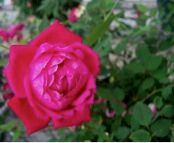
Credit: Jozer Mangandi
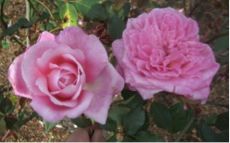
Credit: Sydney Park Brown, UF/IFAS
Research in Florida has shown that roses grafted on 'Fortuniana' rootstock (Rosa fortuniana, 'Double White Cherokee') grow larger, are more vigorous, produce more flowers, and live much longer than plants grown on any other rootstock. 'Dr. Huey' rootstock is a distant second-best, and 'Multiflora' (Rosa multiflora) is the shortest-lived and least satisfactory rootstock under Florida conditions. Many "old" roses and dwarf cultivars perform well on their own roots but often do better when grafted.
Beyond the choices of high- or low-maintenance and types of rootstock, selecting roses depends on your preference for flower color, fragrance, and shape as well as plant form. Some roses make attractive landscape plants; others have poor landscape appeal but produce beautiful cut flowers. Some, like the miniatures, mini-floras, and patio roses, readily adapt to small spaces or containers. A local rose society can also provide you a wealth of information on which roses perform best in your area of the state. For more information, see https://www.rose.org/ and https://deepsouthdistrict.org/.
Site Selection and Soil Preparation
Roses need direct sunlight for at least six hours a day. Open locations where the roots of nearby plants will not compete for nutrients and moisture are preferred. Where shade cannot be avoided, choose a location that supplies morning sunlight to dry the dew off leaves, which will decrease the chance of fungal disease. Also, select roses that produce flowers with a single row of petals—many rose growers claim that the fewer the petals, the more shade tolerant the rose is likely to be. Roses can be grown satisfactorily near the coast with adequate soil preparation and maintenance and protection from salt spray. Most roses are not tolerant of irrigation water (reclaimed or well water) with more than 1,800 ppm salts.
The best soil for growing roses is one that is well-drained but, at the same time, holds an adequate supply of moisture and nutrients. Most Florida soils should be amended. Adding organic material such as compost, manure, or peat will increase the water- and nutrient-holding capacity and the overall health of the soil and the plants growing in it. Soil amendments should be added to the entire bed not just to the planting hole because roots quickly grow beyond the amended area. Add 2–4 inches of organic material and mix amendments thoroughly and evenly to a depth of 12 inches. These materials are especially beneficial when added to light, sandy soils and to soils that compact easily. Where soils are poorly drained, it will be necessary to create raised beds.
Nutrients are most readily available to the roots in a moderately acid to slightly acid soil (pH 5.5 to 6.5). Your county Extension office can provide you information on having your soil tested for pH: https://sfyl.ifas.ufl.edu/find-your-local-office/.
Planting and Early Care
Local nurseries typically have containerized roses for sale year-round, whereas dormant, bare-root plants are usually available from October to March. Be aware that bare-root plants are seldom grafted on 'Fortuniana' rootstock and therefore may not thrive in Florida. Roses can be planted year-round except in north Florida, where planting is best delayed until early spring. Repeated freeze injury to new shoots exhausts stored food and can kill plants that lack well-established root systems.
Compared to other regions of the US, roses in Florida grow larger and require more space than is recommended in other states. The space allowed for different plant growth habits ranges from a circle of one foot diameter for the smallest shrubs to a circle eight feet in diameter for the largest. Old garden roses, like Chinas and Teas, are slow to establish and typically "sleep, creep, and leap" over the course of several years.
Dig a hole as deep as the root ball or slightly shallower. Remove the root ball from the container and gently loosen circling roots. Plant the rose at the same depth that it was growing in the container. This ensures that the graft union (if it is grafted) remains well above the soil. Fill the hole with soil and water thoroughly. Apply a 2- to 3-inch layer of mulch (compost, wood chips, pine needles, etc.) around each plant keeping the mulch an inch or so away from the main stem. Irrigate frequently for 6–8 weeks to establish.
Larger roses should be tied to a well-anchored stake or trellis for support. Metal stakes made from pipe sections, electrical conduit, or reinforcing rods (rebar) are quite satisfactory. Cover the metal stake with clear plumbing tubing so that it will not scrape and injure the plant, and use durable, soft material for ties.
Maintenance
Roses grow year-round in Florida; therefore, some maintenance is required throughout the year. Again, the type of rose you choose will dictate the maintenance level needed. Most modern roses, hybrid tea roses, and grandiflora roses need weekly watering and spraying, frequent grooming to remove old flowers, fertilizing after each flush of bloom, and pruning and mulching in early spring. Low-maintenance roses such as 'Bourbon', 'China', 'Bermuda', 'Tea' (not hybrid tea), and "shrub" roses typically require minimal care.
Cold-protection methods commonly used in colder climes are unnecessary in Florida because winter injury to mature wood of established rose bushes rarely occurs. More flowers are produced during summer than during cooler seasons, but flowers are larger, more intense in color, and have more petals during cooler periods of the year.
Irrigation
Frequent applications of water are necessary for modern roses and even low-maintenance roses will benefit from an occasional irrigation during drought periods. When overhead sprinkling is used, water early enough for the leaves to dry before sundown. Microirrigation systems such as drip tubing or microsprayers are ideal because the foliage stays dry and less prone to disease.
Fertilization
Fertilizing varies depending on the season, the location, and the size of plants. Select a fertilizer formulated for roses, preferably one containing micronutrients and controlled-release nitrogen. There is little research on growing roses in Florida, but rose growers usually recommend that roses should be fertilized once a month from mid-February to mid-November, except in south Florida, where monthly applications can be made year-round. Apply one cup of fertilizer per plant per application or ½ cup bimonthly. Reduce this amount and frequency for small plants, old garden roses, and shrub roses.
Mulching and Weeding
An organic mulch around roses will hold moisture in the soil and reduce weed growth. Replenish mulch as it decomposes. Remove weeds in rose beds by pulling them or by shallowly cutting them with a hoe.
Grooming
Grooming is a regular feature of rose culture, and the frequency will depend on the type of rose and your expectations. Grooming consists of selectively trimming plants to keep them healthy, well-shaped, and productive. Dead-head (remove faded flowers) after each flush of bloom to improve plant appearance and prevent the development of fruit (i.e., rose hips). This directs plant energy into new growth and blooms.
Remove suckers (leafy shoots) that grow from the rootstock by breaking them off (rather than cutting) in order to remove all basal buds. Rootstock suckers can be recognized by their location below the graft union and their different leaf appearance. "Blind" shoots—shoots that fail to set a flower bud—are occasionally produced by roses and should also be removed as soon as they are detected.
Remove dead wood and canes showing stem disease symptoms as soon as you notice them. Cut the affected stems back to healthy wood and remove it from the garden area. To avoid dieback and encourage rapid repair, pruning cuts should be made just above a dormant bud (eye). When an entire branch is removed, make a smooth cut where it joins the trunk.
Pruning
In central and north Florida, hybrid teas, grandifloras, and floribundas should receive a major pruning in mid-February/early March. In south Florida, many rose growers prune these types in early December. Major yearly pruning consists of shortening main canes and lateral branches, and removing twigs and canes that are dead, diseased, injured, or spindly. This improves form, regulates height, and improves air circulation and light penetration within the plant. Main canes that are one- to three-years old should be left at least half their length. The first flowers can be expected eight to nine weeks after pruning. Most gardeners prune again in August, but this is a lighter pruning of ¼ to ⅓ of the growth. Other types of roses, particularly OGRs like the Chinas and Teas, are lightly pruned only as needed.
Cut Flowers
When cutting flowers, consider the arrangement in which they are to be used. Larger, more open flowers to be used low in the container need less stem length than tighter buds to be used for height (Figure 3).
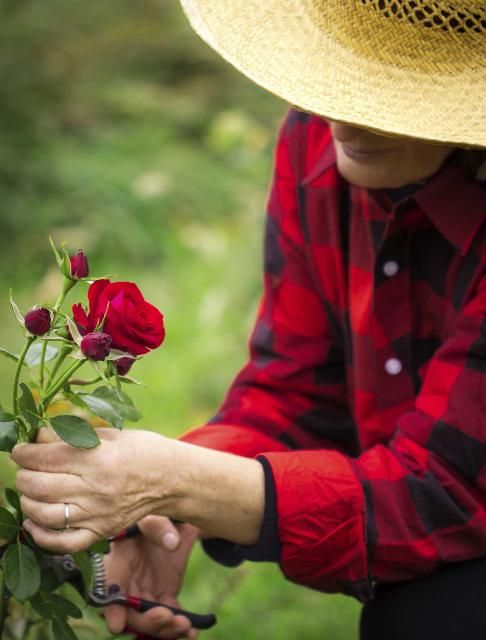
Credit: Thinkstock/iStock/miguelphoto78
Cut flower buds after the green sepals fold back toward the stem and the outside petals loosen and start to unfurl. Blooms cut in tighter bud will fail to open. Use a sharp knife or pruning shears for cutting flowers, and make a clean cut just above a well-developed, five-leaflet leaf. Dieback may result from leaving a ragged cut or a long stub above the dormant bud.
To produce single-stemmed, exhibition flowers, remove the lateral flower buds as they form, allowing one bud to mature on each stem. To regulate the time of bloom for a particular variety, pinch out all flower buds as they form until 28 to 34 days before flowering is desired.
Pest Management
Certain roses require weekly sprays of fungicides and insecticides to maintain their quality. Because of the heavy reliance on pesticides, it is important that growers rotate products to prevent rose pests from developing chemical resistance (https://edis.ifas.ufl.edu/in714). The most serious problem with roses in Florida are two fungal diseases called black spot and Cercospora leafspot (Figures 4 and 5). These leaf spot diseases thrive in humid, wet weather and must be managed preventatively, or infected plants will lose leaves, decline, and possibly die. Sanitation plays a major role in managing infections on susceptible varieties. After the winter pruning, remove all leaves from the plants, and rake the area beneath the bush to remove dead and diseased leaves that have fallen during the year. Re-mulch immediately to create a physical barrier between the plant and the fungal spores on the ground, which otherwise will splash onto the plant and reinfect it. Begin spraying as new growth emerges, and continue throughout the growing season. Most low-maintenance roses are resistant to these diseases to a greater or lesser degree and will survive with few to no sprays. Research has shown that black-spot-resistant varieties are more susceptible to Cercospora leafspot and vice versa. Both diseases can also be managed by irrigating with drip irrigation, which helps keep the foliage dry and less susceptible to fungal infection. For more information on these leafspots, see Black Spot of Rose (https://edis.ifas.ufl.edu/pp268) and Cercospora Leaf Spot of Rose (https://edis.ifas.ufl.edu/pp267).
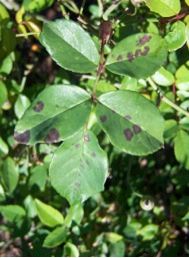
Credit: Jozer Mangandi
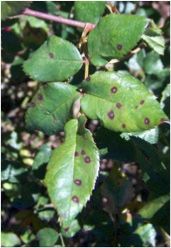
Credit: Jozer Mangandi
Powdery mildew is another fungus disease that attacks roses during spring or late fall when the days are warm and nights are cool. The disease covers new leaves and flower buds with a distinctive white, powder like growth. Although leaves and blooms are damaged by powdery mildew, the disease rarely kills the plant. Again, many low-maintenance roses exhibit resistance to this disease as well.
Other common pests of roses include aphids, spider mites, caterpillars, and flower thrips. Another pest, chilli thrips, attack the flowers and the foliage and are a serious pest of roses (http://mrec.ifas.ufl.edu/lso/thripslinks.htm and http://entnemdept.ufl.edu/creatures/orn/thrips/chilli_thrips.htm). For more information on these and other rose pests, see https://edis.ifas.ufl.edu/topic_rose_ipm. Frequently monitoring your rose(s) will help you detect early infestations. Your local UF/IFAS Extension office can provide you the safest and most effective strategies for managing insect and disease problems: https://sfyl.ifas.ufl.edu/find-your-local-office/.
References
Knox, G. W, M. Paret, and R. Mizell. Rose Pests and Diseases. EP371. Gainesville: University of Florida Institute of Food and Agricultural Sciences. https://edis.ifas.ufl.edu/ep371
Mangandi, J., and N. A. Peres. 2009a. Black Spot of Rose. PP268. Gainesville: University of Florida Institute of Food and Agricultural Sciences. https://edis.ifas.ufl.edu/pp268
Mangandi, J., and N. A. Peres. 2009b. Cercospora Leaf Spot of Rose. PP267. Gainesville: University of Florida Institute of Food and Agricultural Sciences. https://edis.ifas.ufl.edu/pp267
McFadden, S. E., and R. J. Black. Rose Culture. Circular 344. Gainesville: University of Florida Institute of Food and Agricultural Sciences. http://ufdc.ufl.edu/IR00003605/00001
The Deep South District of the American Rose Society. http://deepsouthdistrict.org/